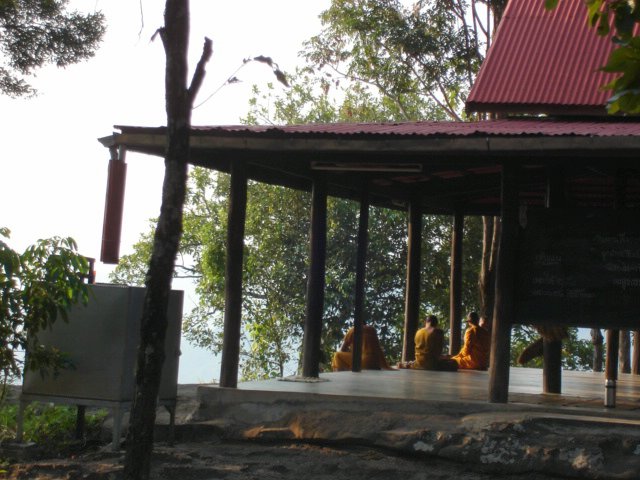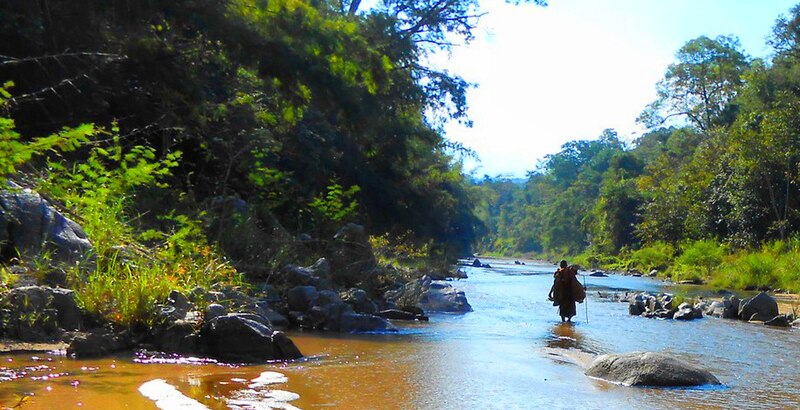
A book newly acquired by the Thammasat University Libraries explores the history of an influential Thai religious group. The Forest Monks of the Rattanakosin Era was written by Venerable Bhikkhu Ariyesako, Venerable Ajahn Nyanadhammo, and Woraphat Arthayukti. The TU Libraries also own related titles, such as The Wandering Forest Monks in Thailand: 1900-1992; Forest Monks and the Nation-state; Forest Recollections; The Buddhist Saints of the Forest; The Autobiography of a Forest Monk; and The Forest Monks of Sri Lanka.
The Forest Monks of the Rattanakosin Era studies the eventful time starting in 1782, the year when Rattanakosin or Bangkok was established as a new capital by King Rama I (Phra Phutthayotfa Chulalok). Buddhist monks who choose to live in a forest, or follow the forest way, are referred to as Phra Thudong (พระธุดงค์). They do so to avoid distractions from human concerns, to better focus on their studies and meditation. These monks tend to travel from one temple to one another.
Phra Ajaan Lee
One of the leading 20th century Thai forest monks was Phra Suddhidhammaraisa Gambharamedhacariya, (1907–1961), known as Ajaan Lee Dhammadharo. He taught in the Dhammayuttika Nikaya order of Theravada Buddhism. There are many lively stories about the life and work of Phra Ajaan Lee. According to his memoirs, when he was about aged twenty, he killed a dog which had stolen an egg he was cooking. As a way of showing regret for this action, he decided to become a monk. When he did so, he did not approve of the way other monks around him were behaving. They seemed to spend too much time having fun playing chess, and ate food in the evenings instead of fasting. He decided to walk in the forests, on trips that took him to Burma, Cambodia, and India. To set an example, he would sleep in cemeteries, which people who lived in villages would avoid out of fear of ghosts. He was also unafraid of forest animals, including tigers, wild elephants, and snakes. He would claim that these were guardian spirits in disguise to test the monks. According to one story, Phra Ajaan Lee meditated with such concentration that he could order mosquitoes not to sting him and tigers not to bite.
Other monks would not be so fortunate. In February 2008, news reports indicated that wild elephants had killed one monk and injured another in Thap Lan National Park in Nakhon Ratchasima province. The monks were part of a group who were meditating in Khon Buri Forest Reserve inside the park. Thap Lan National Park director Yuthanna Sringernngam told Thai Rath daily:
This is elephant mating season, so they are very dangerous, and if you meet a herd of pachyderms now, you should just run away.

International impact.
The Kammaṭṭhāna Forest Tradition of Thailand, also known as the Thai Forest Tradition, has inspired many people around the world. In 1975, Wat Pah Nanachat, the International Forest Monastery was founded in Northeast Thailand, to teach English-speaking people the Theravada Forest Tradition.
Ven. Ajahn Chah (1918-1992) established it, modelled after his traditional forest monastery Wat Nong Pah Pong in Ubon Rachathani province. Ven. Ajahn Sumedho, an American disciple, served as the first abbot. Ven. Ajahn Sumedho was born Robert Karr Jackman in 1934 in Seattle, Washington. He is considered the senior Western representative of the Thai forest tradition of Theravada Buddhism. The Thammasat University Libraries own several of his books. In the 1980s, Ven. Ajahn Sumedho helped to found the Abhayagiri Buddhist Monastery in northwestern California, USA. Ven. Ajahn Sumedho, who was then in the United Kingdom, received requests to teach in California. Eventually, land was donated to establish a monastery, which currently occupies 280 acres of mountainous forest terrain.
Another example of the Thai tradition inspiring people overseas is the Metta Forest Monastery in San Diego County, California. Metta Forest Monastery is a meditation monastery in the Thai Forest tradition. Founded in 1990 by Ajaan Suwat Suvaco, it has been directed by Thanissaro Bhikkhu (Ajaan Geoff) since 1993. The Monastery is outside of Valley Center, California at the end of a road in an avocado orchard surrounded by mountains. Reportedly there are nine American monks and one Thai monk living there now. The TU Libraries also own many books by Thanissaro Bhikkhu. In the United Kingdom, Ajahn Sumedho and other UK-based Buddhists were also involved in the founding of Cittaviveka – also known as Chithurst Buddhist Monastery – in West Sussex, Harnham Buddhist Monastery, Aruna Ratanagiri Buddhist Monastery, and The Forest Hermitage (Santidhamma & Bhavanadhamma).
According to its website, Cittaviveka
is a residence for bhikkhus (monks) and siladharas (nuns), where their life of training in ethics, meditation and renunciation can be supported in a quiet rural environment. The monastery is not a retreat centre, but a living environment of woodland, ponds, wildlife – and human dwellings. Here, through ethical guidelines, meditation and community work, we practise living in harmony. The community welcomes men and women who wish to visit, stay as guests or make a commitment to the monastic life. Like the Buddha’s teaching, the beauty and peace of Cittaviveka can only be experienced by entering into it; however, this website is an invitation for you to browse and ‘come and see’ for yourself in advance.

Other monasteries.
The Thai Forest Tradition has also spread to Canada, New Zealand, Switzerland, Germany, and Italy. Santacittarama, which is Italian for The Garden of the Serene Heart, was founded in 1990. It is located in the Sabina hills, about 50km. from Rome, in the district of Poggio Nativo, Rieti province. In Switzerland, Kloster Dhammapala is in Kandersteg in the canton of Bern in Switzerland. It is found along the valley of the River Kander, west of the Jungfrau massif, known for its spectacular mountain scenery and alpine landscapes. A popular site year-round for hiking and mountain-climbing as well as downhill and cross-country skiing, Kandersteg offers the natural surroundings that help meditation. Bodhinyanarama Monastery is located in a 126 acre wooded valley near Wellington, New Zealand. The wooded area with isolated living places offers appropriate solitude. Also in New Zealand is Vimutti Buddhist Monastery. As its website notes,
Created with the intention of generating peace and wisdom in the world, Vimutti is situated in the midst of 144 acres of native bush, pine forest, streams and rolling hills. The monastery offers seclusion and suitable conditions for those who wish to deepen their meditation, as well as the opportunity for people of all nationalities to join together in harmony and work towards a noble common goal… The name Vimutti was chosen for this monastery because it represents the highest and most noble potential for a human being. This term in the Pali language means liberation or ultimate freedom.
Tisarana Buddhist Monastery is in Perth, Eastern Ontario, Canada. These and other locations follow the Thai Forest Tradition, showing how widespread its ongoing international influence remains.

(All images courtesy of Wikimedia.com)
